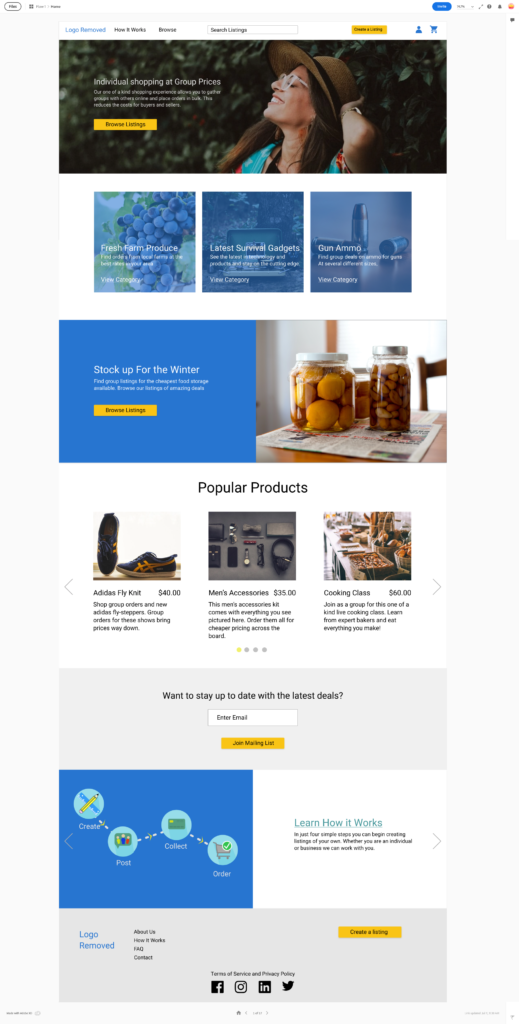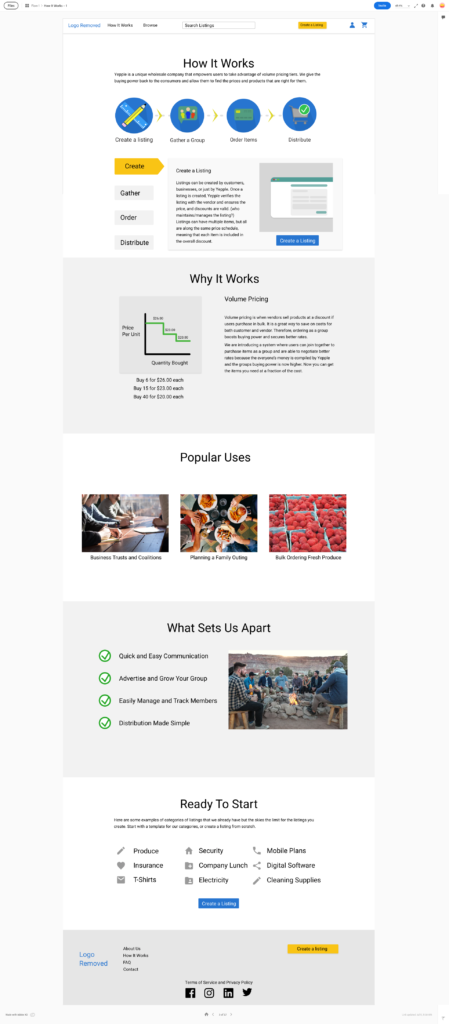What It Is:
Yepple is an online application that aims to help users coordinate group orders. Users can create a group order to sell a lot of products at once, or join group orders with other people to order individual items at huge discounts because the group is ordering in bulk.
My Role:
I was the sole UX designer that worked on Yepple. I did all the wireframes and prototypes and even wrote some of the content and coded some of the landing pages.
Key Issues:
How do you make this make sense? Many users are familiar with ecommerce shopping experiences. However, not very many people are trained to think about ordering as a group. There are a ton of little complexities involved so I had to solve this complexity while also displaying it to the end user in a simple way that they can understand it.
Focus. One of the biggest problems that the organization as a whole had was focus. When I was first brought on, yepple was an exciting brand that had nothing but possibilities. The issues were that with all of the different things we could do, we had trouble narrowing our focus to one specific audience.
Initial Research:
The original problem we tried to solve was how to easily coordinate groups of people. We were familiar with ordering things in bulk to get better pricing. We wanted this pricing to be available to the everyday consumer who didn’t have a huge group of people to back them up.
During my research I found that this problem is not a big enough problem which means the product may never become something consumers ‘must have’. When was the last time you struggled ordering as a group? For many of our users, it was basically never because the substitution for that is just order by yourself or have one person order and everyone sends money to that person. So we realized that we needed to find a different problem to solve.
During a user test I did with an owner of a local cupcake shop, I found that they were interested in using the product to sell their own cupcakes. They had wanted to do bigger orders because it makes their jobs easier. They can sell more of their products to a guaranteed larger audience at a slightly lesser price. Their margins would increase a lot because there is significantly less production costs to bake and sell a lot of cupcakes at once.
Problem Statement: Small business owners need a simple and convenient way to package, sell, and market their products to large groups of people without dealing with complexities of group orders.
Solutions:
After looking over the data, we decided to focus on building a business tool. It was clear that a group order tool would need to be pitched as software to help businesses to sell large quantities of their products. We had to start off selling the service to businesses so they would list their products on our site in the first place. We would then become a company marketing tool for businesses to use to grow and manage their customers.
Persona:
Tom – Insurance agent focusing on rental properties
Is experienced and has reached out and sold to most of the places in his area.
Looking to expand his area of influence.
Wants to start rental groups to secure better insurance rates for his customers and give himself a better competitive advantage by offering better pricing for group rates.
Bountiful Baskets – Bountiful Baskets is a small business focused on the group order of fresh produce for people in the Bountiful area. They have been using spreadsheets and an old website to manage these orders but things have gotten complicated as they have grown. They are looking to invest in something to help them manage these group orders.
Prototypes


What We Learned
I did not have the pleasure of seeing this project all the way but before I left, we learned a ton about our users through a few test orders we did with a local cupcake shop. The biggest problems that we were still unable to solve when I changed companies were:
- The biggest hurdle was the delivery of the product to everyone within the group. This not only became really challenging business-wise, but it also was difficult because we did not want to so easily turn over customer data to anyone who creates a group order. So we needed to figure out how we could get the product delivered without revealing personal data to the listing creator.
- Monetization of this product was seriously difficult. The problem was that the benefit of this system is the huge discounts one would receive. Much like Groupon, it would be seriously difficult to produce income if the entire selling point of our platform is the savings you can receive. Our paper-thin margins, whether we charged users or businesses, never really amounted to enough to live on. The solution we ended on was a monthly subscription for businesses wanting to use the service but this solution still has its flaws.
Overall, the biggest plague in this product was a lack of identity. I think our team had so many ideas for what we wanted this app to become that it ultimately left us without much of a leg to stand on. The product had so much potential and we could all see it, but the executions never reached the level we had hoped.
I really think this shows the importance of designing with the user in mind from the outset of a project. I believe our team was too focused on designing cool features and things that we wanted to use instead of building an application a business would pay for. I believe we as a team solved the wrong problem as well. We did not validate how many other businesses were looking for a group ordering service. We did not research thoroughly enough what substitutes exist. We solved a problem that wasn’t big enough and in return, got very little traction when we tried to sell it.

